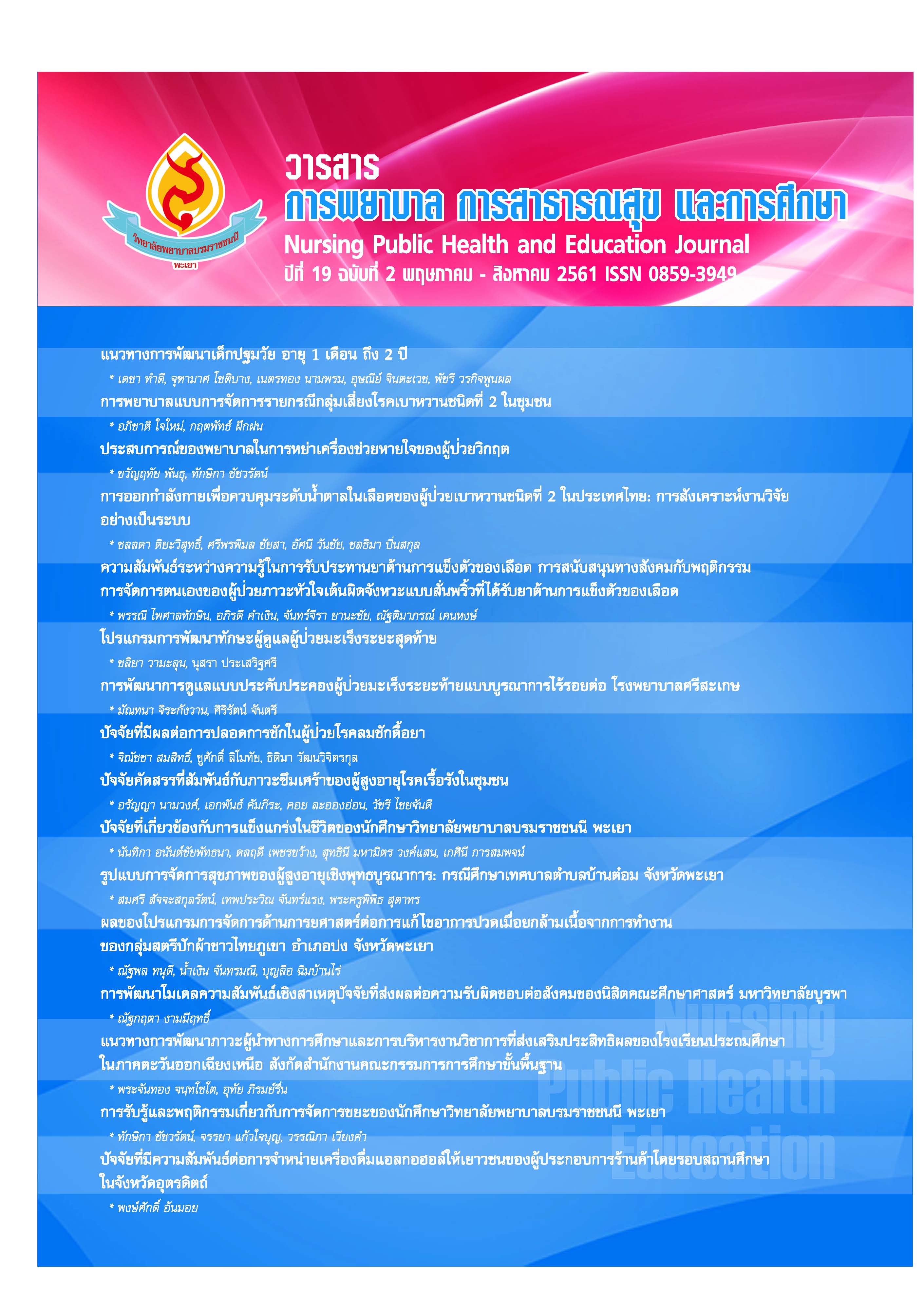โปรแกรมการพัฒนาทักษะผู้ดูแลผู้ป่วยมะเร็งระยะสุดท้าย
คำสำคัญ:
ผู้ดูแลผู้ป่วย, ทักษะผู้ดูแลผู้ป่วย, ผู้ป่วยโรคมะเร็ง, Caregiver, Caregiver Skills, Cancer Patientsบทคัดย่อ
การพัฒนาทักษะผู้ดูแลผู้ป่วยมะเร็งระยะสุดท้ายมีความสำคัญและจำเป็น เพื่อสนับสนุนให้ผู้ดูแลสามารถดูแลผู้ป่วยมะเร็งระยะสุดท้ายได้อย่างต่อเนื่อง การวิจัยและพัฒนาครั้งนี้มีวัตถุประสงค์เพื่อพัฒนา และประเมินผลของโปรแกรมพัฒนาทักษะผู้ดูแลผู้ป่วยมะเร็งระยะสุดท้าย กลุ่มตัวอย่างขั้นตอนการศึกษาวิเคราะห์สภาพการณ์ ประกอบด้วย ผู้ดูแลผู้ป่วยมะเร็งระยะสุดท้าย 30 คน และ กลุ่มตัวอย่างในขั้นตอนประเมินโปรแกรมประกอบด้วย ผู้ดูแลผู้ป่วยมะเร็งระยะสุดท้ายจำนวน 30 คน เครื่องมือที่ใช้ในการวิจัยประกอบด้วย แบบสำรวจ แบบสัมภาษณ์กึ่งโครงสร้าง และแบบประเมินทักษะผู้ดูแลผู้ป่วยระยะสุดท้าย สถิติที่ใช้ในการวิเคราะห์ข้อมูลได้แก่ ร้อยละ ค่าเฉลี่ย ส่วนเบี่ยงเบนมาตรฐาน สถิติทดสอบค่าทีและการวิเคราะห์เนื้อหา ผลการศึกษาพบว่า โปรแกรมการพัฒนาทักษะผู้ดูแลผู้ป่วยมะเร็งระยะสุดท้ายประกอบด้วย10 หน่วยเรียน จำนวน18 ชั่วโมง พัฒนาทักษะใช้เทคนิคการสอนเชิงปฏิบัติการพัฒนาทักษะ 9 ด้าน ได้แก่ 1. ด้านการเฝ้าระวัง 2. ด้านการแปลความหมาย 3. ด้านการตัดสินใจ 4. ด้านการปฏิบัติการ 5. ด้านการปรับกิจกรรมตามความเหมาะสม 6. ด้านการเข้าถึงแหล่งสนับสนุน 7. ด้านการให้การดูแล 8. ด้านความร่วมมือกับผู้ป่วย และ 9. ด้านการเข้าถึงระบบการดูแลสุขภาพ ผลการประเมินโปรแกรมพัฒนาทักษะผู้ดูแลผู้ป่วยมะเร็งระยะสุดท้าย เปรียบเทียบทักษะผู้ดูแลผู้ป่วยก่อนและหลังใช้โปรแกรมการพัฒนาทักษะพบว่าผู้ดูแลผู้ป่วยมีทักษะ 5 ด้านเพิ่มขึ้นอย่างมีนัยสำคัญทางสถิติที่ระดับ.05 โปรแกรมการพัฒนาทักษะผู้ดูแลผู้ป่วยมะเร็งระยะสุดท้ายมีความเหมาะสมในการพัฒนาทักษะผู้ดูแลผู้ป่วยมะเร็งระยะสุดท้าย
Program to Development of Caregiver Skills for End of Life’s Cancer Patients
Developing caregiver skills for the end- of- life (EOL) cancer patients is important to encourage caregivers to caring continuously of patients with terminal cancer. The aim of this research and development study was to develop and evaluate of the model development of caregiver skills for EOLin cancer patients. The subjects were 30 EOL caregivers in the phase of situation analysis, and 30 EOL caregivers in the evaluation phase. The research tools were questionnaires, semi structured interviews, and caregiver skills questionnaires. Data were analyzed by using percentage, mean, standard deviation, pair t-test, and content analysis. The research found that the program for developing caregiver skills consisted of 10 units of 18 hours. The development skills were using action learning techniques for improving 9 skills that composed of 9 domains caregiver skills including 1) monitoring, 2) interpreting, 3) making decisions, 4) taking action, 5)making adjustments, 6) providing hands-on care, 7)accessing resources, 8)working together with the ill patients, and 9) navigating the healthcare system. The evaluation of the development model of caregiver that comparing skills of caregivers before and after obtaining the model found 5 skills significantly increased (p<0.05). Program to development of caregiver skills for EOL’s Cancer patients is applicable forimproving caregiver skills to caring patients.
เอกสารอ้างอิง
ปพิชญาลักษณ์ ตันดี, สิริลักษณ์ โสมานุสรณ์, และชมนาด สุ่มเงิน. (2559). ปัจจัยที่มีความสัมพันธ์กับความต้องการ
ของผู้ดูแลวัยสูงอายุที่ดูแลสมาชิกในครอบครัวที่ป่วยเป็นมะเร็ง. วารสารวิทยาลัยพยาบาลบรมราชชนนี
กรุงเทพ. 32(2).
ศุภศิริ เชียงตา, วัลย์ลดา ฉันท์เรืองวณิชย์, อรพรรณ โตสิงห์, &ภาวิน เกษกุล. (2560). การศึกษาความสัมพันธ์ของความต้องการการดูแลแบบประคับประคองระหว่างผู้ป่วยมะเร็งศีรษะและคอกับผู้ดูแล. วารสารสภาการพยาบาล, 32(2), 31-48.
Alvarez, K., Salas, E., &Garofano, C. M. (2004).An integrated model of training evaluation and effectiveness.Human resource development Review, 3(4), 385-416.
Applebaum, A. J., & Breitbart, W. (2013). Care for the cancer caregiver: a systematic review. Palliative & supportive care, 11(3), 231-252.
Cox DR, W. N. (1994). Tests of linearity, multivariate normality and the adequacy of linear scores Applied Statistics.
Harding, R., & Higginson, I. J. (2003). What is the best way to help caregivers in cancer and palliative care? A systematic literature review of interventions and their effectiveness. Palliative medicine, 17(1), 63-74.
Hwang, E. J., Lokietz, N. C., Lozano, R. L., & Parke, M. A. (2015). Functional deficits and quality of life among cancer survivors: implications for occupational therapy in cancer survivorship care. American Journal of Occupational Therapy, 69(6), 6906290010p1-6906290010p9.
Ferrell, B., Hanson, J., & Grant, M. (2013). An overview and evaluation of the oncology family caregiver project: improving quality of life and quality of care for oncology family caregivers. Psycho‐Oncology, 22(7), 1645-1652.
Kendall, M., Murray, S. A., Carduff, E., Worth, A., Harris, F., Lloyd, A., . . . Sheikh, A. (2009). Use of multiperspective qualitative interviews to understand patients’ and carers’ beliefs, experiences, and needs. Bmj, 339, b4122.
Grant, M., Sun, V., Fujinami, R., Sidhu, R., Otis-Green, S., Juarez, G., ...& Ferrell, B. (2013, July). Family caregiver burden, skills preparedness, and quality of life in non-small-cell lung cancer.In Oncology nursing forum, (Vol. 40, No. 4, p. 337).NIH Public Access.
Given, B. A., Given, C. W., & Sherwood, P. R. (2012). Family and caregiver needs over the course of the cancer trajectory. The journal of supportive oncology, 10(2), 57-64.
Lugton, J., &Kindlen, M. (1999).Palliative care: The nursing role.New York : Churchill Livingstone.
Lunneyand others. (2003). Patterns of functional decline at the end of life, JAMA, 289(18),2387-2392.
Reinhard, S. C., Given, B., Petlick, N. H., & Bemis, A. (2008). Supporting family caregivers in providing care.RetrievedDecember14,2017, fromhttps://www.ncbi.nlm.nih.gov/books/NBK2665/
Murray SA, Kendall M, Grant E, Boyd K, Barclay S, Sheikh A.(2007).Patterns of social psychological and spiritual decline towards the end of life in lung cancer.J Pain Sympt Man; 34: 393-402
Northouse, L. L., Katapodi, M. C., Song, L., Zhang, L., & Mood, D. W. (2010). Interventions with family caregivers of cancer patients: meta‐analysis of randomized trials. CA: a cancer journal for clinicians, 60(5), 317-339.
Phillips, L. R., & Reed, P. G. (2009). End-of-life caregiver’s perspectives on their role: Generative caregiving. The Gerontologist, 50(2), 204-214.
Schumacher, K. L., Beidler, S. M., Beeber, A. S., & Gambino, P. (2006). A transactional model of cancer family caregiving skill. ANS Adv Nurs Sci, 29(3), 271-286.
Schumacher, K. L., Stewart, B. J., Archbold, P. G., Dodd, M. J., & Dibble, S. L. (2000). Family caregiving skill: development of the concept. Res Nurs Health, 23(3), 191-203.
Siegel, R. L., Miller, K. D., & Jemal, A. (2015). Cancer statistics, 2015. CA Cancer J Clin, 65(1), 5-29. doi: 10.3322/caac.21254
Wood, D. E. (2015). National Comprehensive Cancer Network (NCCN) clinical practice guidelines for lung cancer screening. Thoracic surgery clinics, 25(2), 185-197.
World health organization.(2002).National Cancer Control Program es.Policies and managerial guideline.Geneva :WHO Press, 84.
World health organization.(2006).National Cancer Control Program es.Policies and managerial guideline.Geneva :WHO Press,14.
World health organization.(2007).National Cancer Control Program es.Policies and managerial guideline.Geneva:WHO Press ,22-31.



